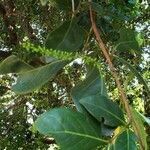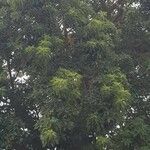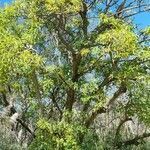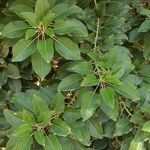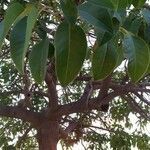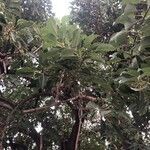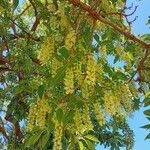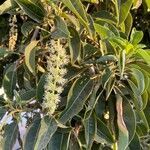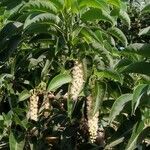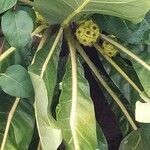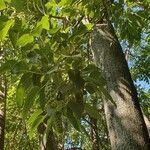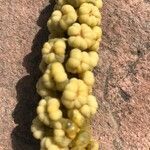Tree to 7 m high, papillate, glabrescent. Leaves petiolate, ovate to broadly ovate, acute, apiculate; lamina to 12 cm long and 7.5 cm wide; petiole to 7 cm long. Raceme to 20 cm long. Flowers unisexual; pedicels to 5 mm long. Male flowers with ovate or elliptic tepals up to 3.5 mm long, white; stamens 20–30, inserted irregularly; ovary rudimentary. Female flowers with ovate or elliptic tepals up to 4 mm long, white; staminodes c. 10; carpels 7–11; style recurved, c. 1 mm long. Berry depressed-globose, furrowed between seeds, c. 1 cm diam. Seeds ovoid-compressed, c. 3 mm long, shining black.
A large tree. It is evergreen. It grows to 15-20 m high. The crown is dense and spreading. The trunk can be 2 m across. It is swollen at the base. The roots come to the surface and put out suckers. The leaves are green and narrowly oval and taper to the tip. They are simple and 10 cm long. The leaf stalks are narrow. Male and female flowers are separate on separate plants. The flowers are along branched stalks and often hang downwards. These are 10 cm long. The male flowers have 20-30 stamens. The fruit are fleshy berries. They are yellow and have 7-10 cells. The fruit are 1.2 cm across.
Large, cultivated, ornamental tree, up to 25 m high; trunk huge, succulent, soft-wooded, buttressed. Leaves bright green, ovate, base acute, apex hooked-truncate; petioles pinkish, ± 70 mm long. Inflorescences: racemes ± 100 mm long; male and female flowers on separate trees. Flowers creamy yellow, small, up to 100 mm long; pedicels up to 4 mm long. Sepals 5, ± united at base. Stamens 6 or 7 in one whorl. Carpels 5-7, styles ± straight. Flowering time Sept.-Apr. Fruit berry-like, succulent, green turning black, pendent.
